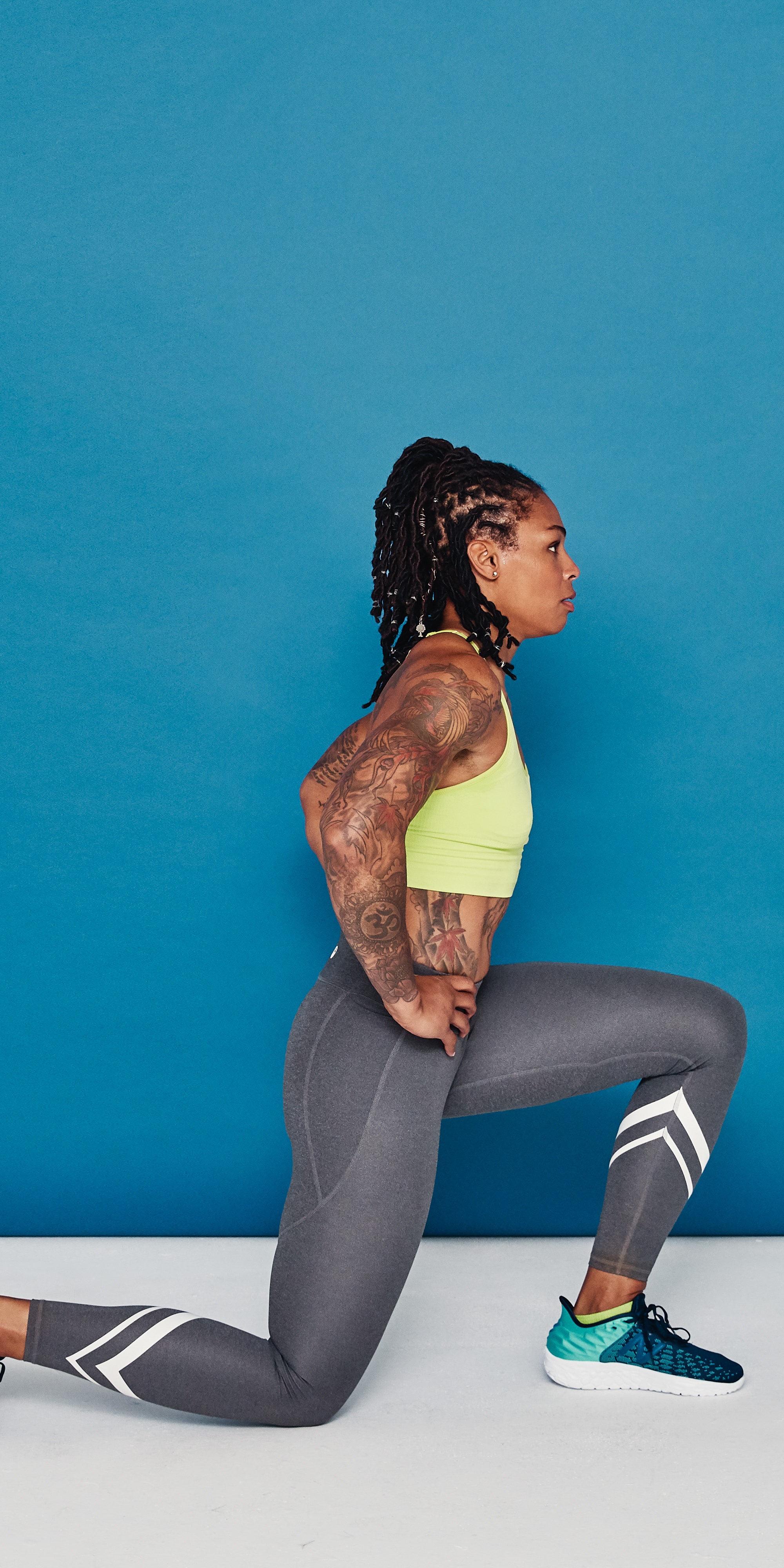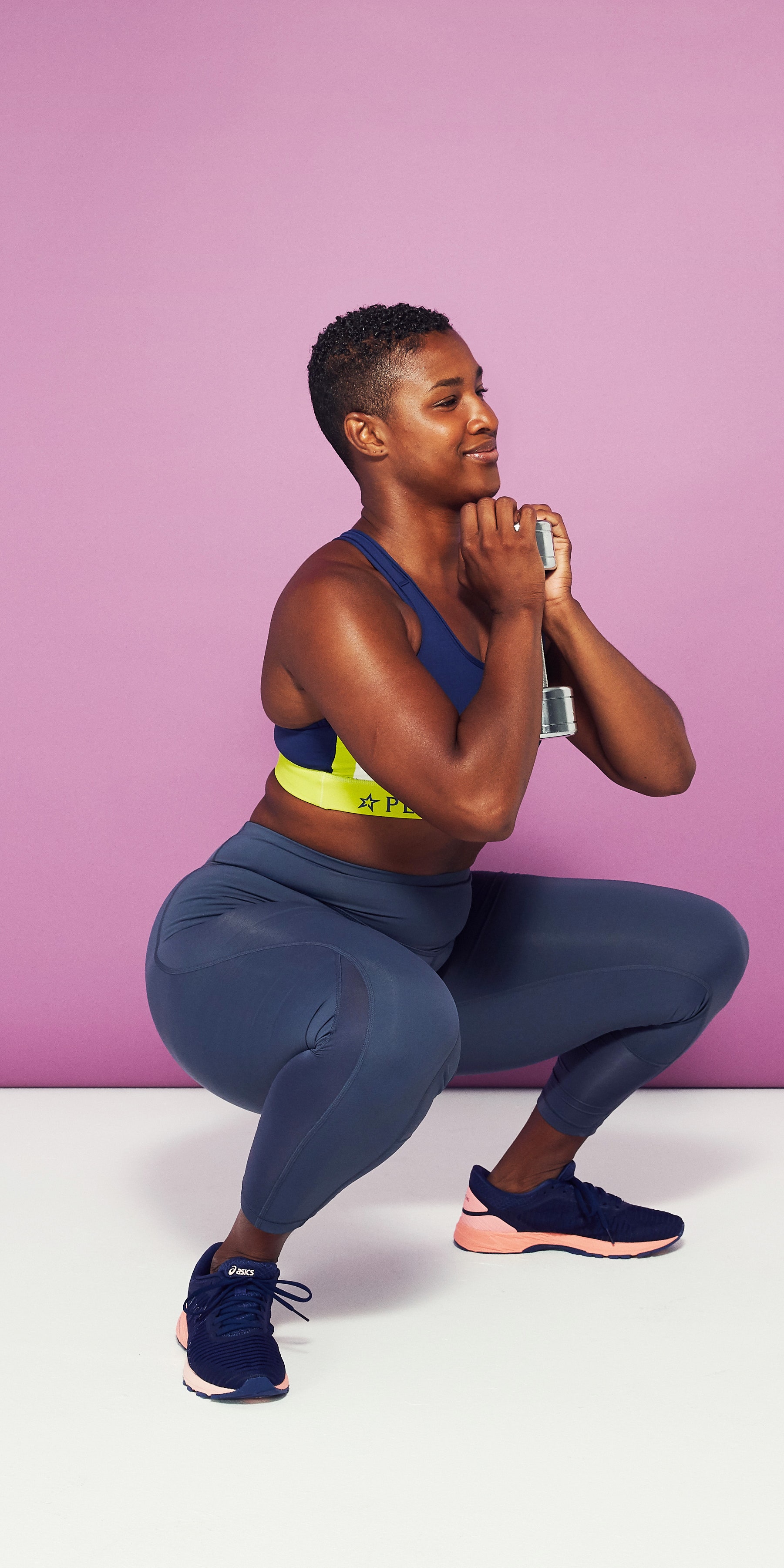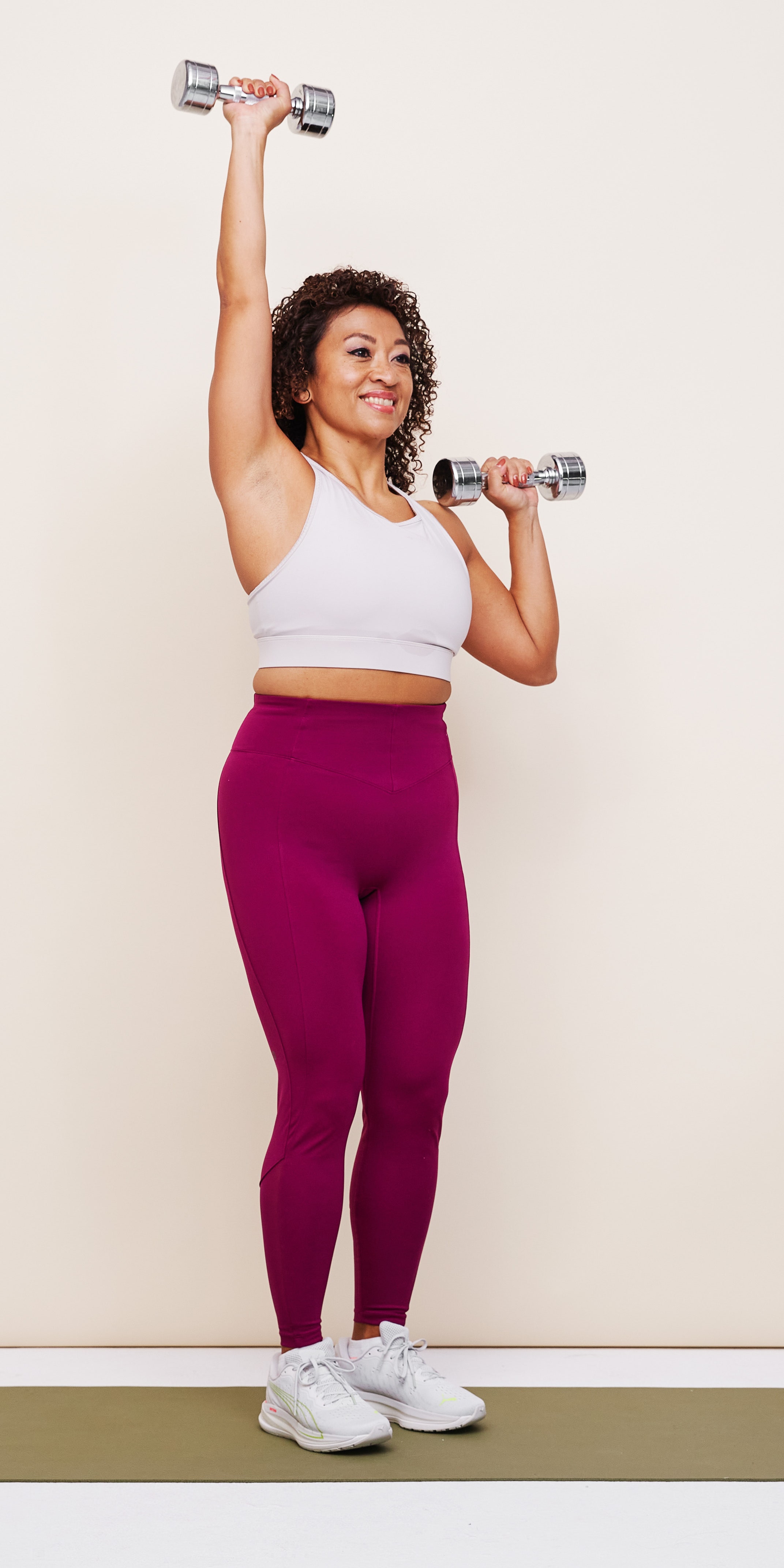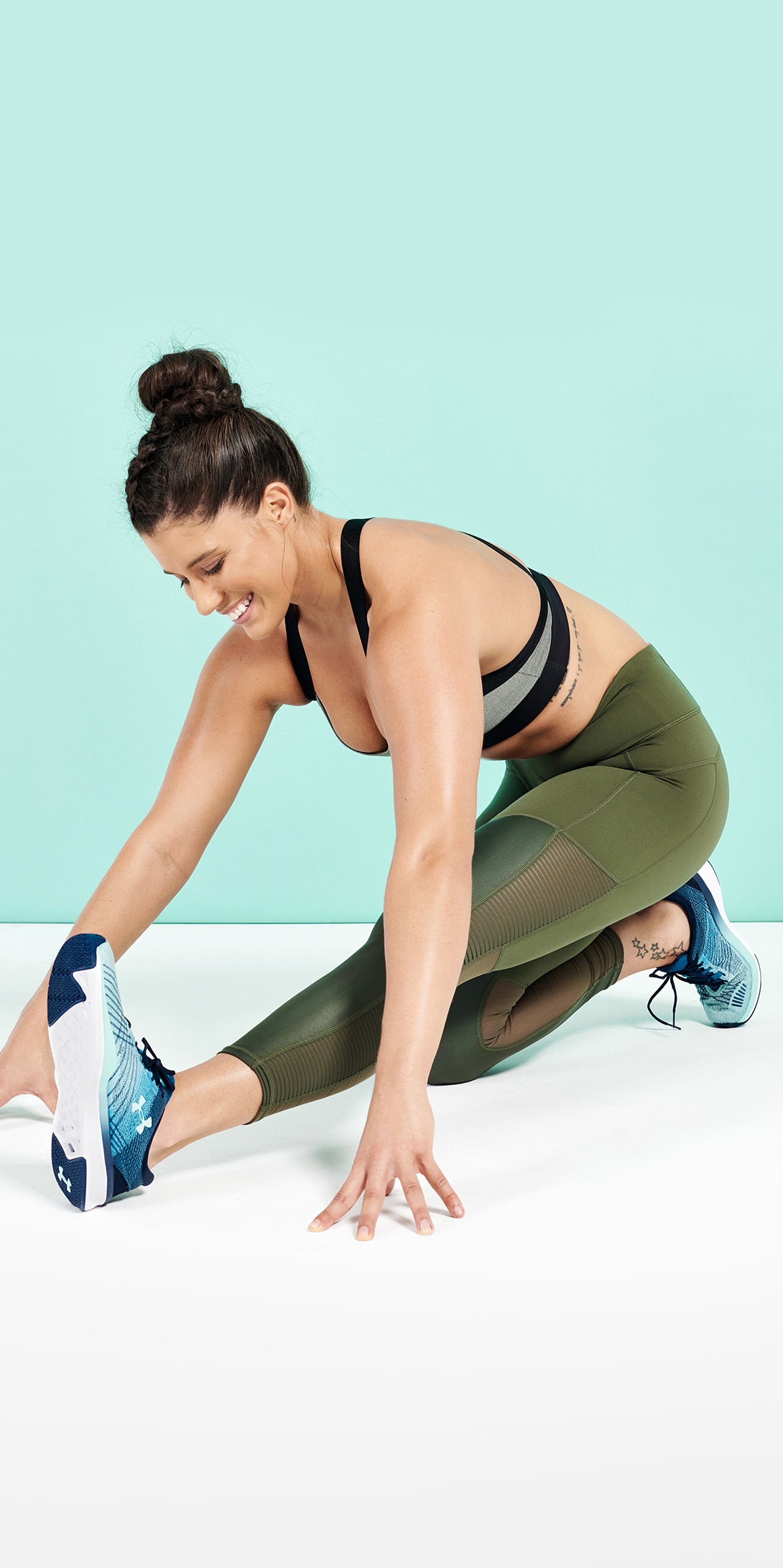When you’re pregnant, your abdominal muscles get stretched and pushed aside to make room for the growing baby in your uterus. In many cases, though not all, the two sides of the main abdominal muscle, the rectus abdominis, will separate. This condition, called diastasis recti, creates a gap between the two sides of the abs and can leave a visible bulge or gap after delivery.
Another physical change that’s less visible (but super important to address) happens in the pelvic floor. The pelvic floor is made up of the major muscles that support your pelvic organs—including the vagina, bladder, and rectum. Just like your abs are stretched, strained, and weakened, your pelvic-floor muscles are impacted by pregnancy. When these muscles don’t function properly, it leads to problems like urinary and fecal incontinence or something called pelvic organ prolapse, which is when the pelvic organs slip out of place and create a bulge (like a hernia).
Luckily, there are some exercises that new moms can do to focus on strengthening both the core and pelvic floor.
“Your focus as a new mom is to first close [the abdominal] separation and heal the muscles of the pelvic floor that suffered significant trauma over your pregnancy and labor,” Ali Handley, founder of BodyLove Pilates, an online source for pre- and postnatal workout videos, tells SELF. Strengthening your core post pregnancy is important first and foremost because your core is the powerhouse of your body. Without basic strength in your midsection, your posture can suffer, you may develop back pain, and it can be more difficult to complete everyday tasks. Your pelvic floor will also benefit from core work if you know how to engage the right muscles. (More on that later.)
Most physical therapists recommend focusing on maintaining core and pelvic-floor strength throughout pregnancy to help lessen the separation and weakening, but even if you do that, rebuilding those muscles is not a quick process. “It takes patience and repetition; there are no shortcuts in postnatal core recovery,” Handley says.
Here, Handley shares five Pilates exercises that are safe for new moms and effective for rehabbing the core and pelvic floor.
-
Pinterest
Bodylove Pilates1 Belly Button to Spine and TVA Counting
“Belly button to spine targets a muscle called the transverse abdominis (TVA), a deep abdominal muscle that wraps around the midsection of the body like a pair of Spanx—lengthening, cinching, and pulling the two sides of the six-pack back together—effectively working to close your diastasis,” Handley explains. The counting part is there to remind you how to breathe and maintain muscle activation as you would in your regular daily activities, Handley says. Here’s how to do it:
- Sit on a physioball, yoga block, or bolster, with your legs crisscrossed underneath you.
- Inhale through your nose and allow your belly to fill with air. “Make sure you completely relax the tummy muscles as you inhale,” says Handley. Allow the rib cage to open up and out.
- Exhale a long, slow, even breath out of your mouth and feel the TVA wrap around your midsection, the two sides of the abs knitting back together. Pull your belly button in toward your spine.
- Repeat, but this time keep engaging your core on the exhale as you count out loud to 10, taking little sips of air throughout.
- Do this each day and start counting a little bit longer when it feels comfortable, working your way up to 25.
Tip: Wrap a scarf around your midsection, over your belly button. “As you exhale, pull the fabric really tight around your midsection. Keep it there as you count,” Handley instructs. It’ll help you feel your muscles engaging, plus it’ll add an extra challenge.
-
Pinterest
Bodylove Pilates2 The Sideways Elevator
“This exercise asks you to imagine your belly button is an elevator. Now turn that elevator on its side and imagine the elevator shaft goes through your tummy to your spine,” Handley says. Here’s how to do it:
- Get on your hands and knees.
- Inhale through your nose and allow your belly to fill with air. Completely relax the tummy muscles.
- Exhale a long, slow, even breath, feeling the TVA wrap around your midsection, the two sides of the abs knitting back together. Imagine that the elevator (your belly button) is moving up the elevator shaft to floors one, two, three, four, and five. Pause for a second at each “floor.”
- Inhale through your nose again and imagine the elevator moving back down to the ground floor (your belly button).
- Pause for a moment at the end of each inhale and exhale.
Modification: If this position is too challenging, do it in a seated position on a physioball, yoga block, bolster, or chair.
Tip: “Watch yourself doing this exercise in a mirror. Make sure that as you pull your belly button in, it is sucking in and not down,” Handley says. “If it is sucking down, place a hand on your bottom ribs, just below your sternum. As you exhale, make sure that you are not pulling down and rounding the spine but rather have a feeling of your sternum lifting further up the body and you are growing taller.”
-
Pinterest
Bodylove Pilates3 Pea Up a Straw
“The pelvic floor is a pretty incredible system, made up of three separate layers of muscles that not only squeeze but also pull together and lift up to support the abdominal organs and your spine,” Handley says. Here’s a good way to isolate and work those muscles:
- Start in child’s pose: Kneel on your mat with your knees hip width apart and your big toes touching behind you. Fold your torso over your thighs, and extend your arms out in front of you.
- Inhale through your nose, taking a deep belly breath and feeling a full release of the pelvic floor.
- Imagine that there is a little pea in the middle of your pelvic floor (between your vagina and anus) and a straw reaching up through your body. Exhale a long, slow breath out of your mouth as you imagine sucking that little pea up the straw.
- Maintain this feeling of squeezing the pea, and hold for a few seconds if you can.
- Inhale through your nose again, and release the pea back to the start position.
Tip: “Pelvic-floor engagement is notoriously hard for some people to feel,” Handley says. “You need to find the right imagery that helps you feel the activation of the muscles. For some, this pea image works.” Here are some other tips for finding your pelvic-floor muscles.
-
Pinterest
Bodylove Pilates4 Heel Slide
This move challenges the TVA and starts to engage other deep core muscles, namely the psoas, “which is a crucial abdominal muscle that connects our spine, pelvis, and legs,” Handley explains. Before you begin this exercise, lie on your back with your knees bent and feet on the floor. “Take a ball, yoga block, or folded towel and place it between your knees,” she instructs. Inhale. Then exhale and squeeze the object between your knees, focusing on the wrap of the TVA. Once you get familiar with that feeling, move on to the heel slide:
- Remain lying on your back, with your knees bent and feet on the floor.
- Inhale through your nose, and allow your belly to fill up with air.
- Slide one foot out along the mat until your leg is straight. Exhale a long, slow, even breath as you feel your TVA engage around your midsection.
- Flex your foot and slide your heel back in along the mat in a slow, focused movement. Be sure to keep the rest of your body planted on the ground.
-
Pinterest
Bodylove Pilates5 Pelvic Tilt
“Your abdominal muscles stretch more than 50 percent over the course of your pregnancy,” Handley says. Here’s a great exercise to tighten them up again:
- Lie on your back, with your knees bent and feet on the floor. Make sure your lower back is flat on the ground.
- Inhale through your nose, and allow your belly to fill with air, completely relaxing the tummy muscles.
- Exhale a long, slow breath out of your mouth. Gently rock your pelvis back, feeling your pelvic floor lift. As you do this, you should also feel your TVA, obliques, and lower abs activating.
- Inhale through your nose again and rock the pelvis forward again.
Tip: With this exercise, less is more, Handley says. “It is a small tilt of the pelvis requiring a deep connection of the abs. You don’t need to force the pelvis back and do a heavy imprint of the spine on the mat.”










Leave feedback about this